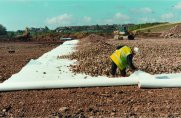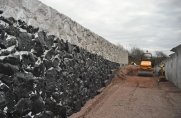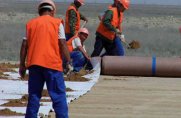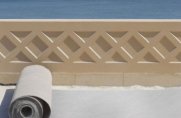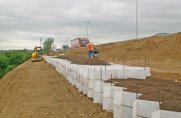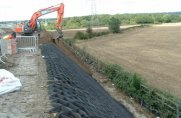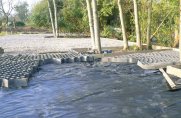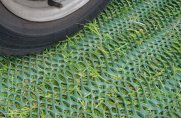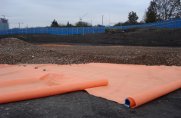- Market Sector
- Application Function
- Products
- Geotextiles
- Civil Geotextiles

Civil Geotextiles
Maintain soil separation and eliminate the mixing of aggregate and sub-base soils. - AASHTO Geotextiles

AASHTO Geotextiles
TYPAR® C-Class construction geotextiles for AASHTO M-288 applications. - Landscape Fabric

Landscape Fabric
TYPAR® Landscape Fabric blocks weeds while letting water and nutrients through.
- Civil Geotextiles
- Geocomposites
- Geocomposite Drains

Geocomposite Drains
TYPAR geocomposite drains are are a highly effective alternative to traditional drainage solutions. - Frost Blanket

Frost Blanket
A purpose-designed, protection geo-composite for mitigating the effects of frost heave. - Salt Barrier

Salt Barrier
Developed to prevent damage caused by the capillary rise of saline groundwater into 'sweet' soil zones.
- Geocomposite Drains
- Geocells
- Geocell - Load Support

TYPAR Geocell - Load Support
TYPAR Geocell GS transfers downward forces, laterally, reducing loads on underlying soils. - Geocell - Slope Protection

TYPAR Geocell - Slope Protection
This system improves resistance to erosive forces on steep, unstable slopes exposed to hydraulic or mechanical depths. - Geocell - Flood Control

TYPAR Geocell - Flood Control
TYPAR GeoCells offer a quicker, easier alternative to sandbags in emergency flood events. - Geocell - Gun Range

TYPAR Geocell - Gun Range
TYPAR GeoCell is the next generation of structures for firing ranges. - Geocell - Erosion and Sediment Control

TYPAR Geooell - Erosion and Sediment Control
TYPAR GeoCell panels provide superior sediment control for stormwater runoff. - Geocell - Mining Containment
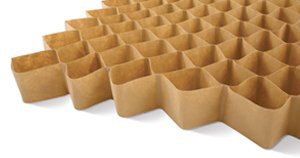
TYPAR Geocell - Mining Containment
Secondary confinement for mining operations. - Defencell - Military and Security Geocell

Defencell - Military & Security
DefenCell™ Protective Wall System for military, security and environmental applications.
- Geocell - Load Support
- Ground Reinforcement Mesh
- GrassProtecta grass reinforcement mesh

GrassProtecta
GrassProtecta grass reinforcement mesh reinforces and protects grass surfaces. - TurfProtecta turf reinforcement mesh

Turf Protecta
An extruded plastic grass reinforcement mesh, providing protection for occasional light vehicle or pedestrian use. - GrassCarpet grass protection

GrassCarpet grass protection
Plastic mesh reinforced geotextile for temporary grass reinforcement for access, parking and grass tracks.
- GrassProtecta grass reinforcement mesh
- Porous Paving
- BodPave 85 Porous Pavers

BodPave 85
Plastic porous paving provides reinforced, durable, safe and eco-friendly surface for grass or gravel filled trafficked areas. - TYPAVE 25 Flexible Porous Paving

TYPAVE™ 25 Flexible Porous Paving
Sustainable porous paving solution for reinforcing grass and gravel surfaces for traffic.
- BodPave 85 Porous Pavers
- Pipe Protection / Underground Marking
- Detectamesh

Detectamesh detectable mesh tape
Detectamesh is a colored plastic detectable mesh for marking and detecting buried underground pipes, cables and services. - Wavelay Detectable Tape

Wavelay Detectable Tape
Wavelay™ is a colored plastic detectable tape for marking and detecting buried underground services. - Underground Warning Tape
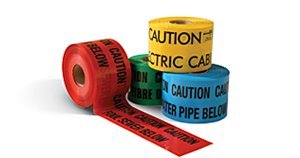
Underground Warning Tape
Polyethylene underground warning tape with a printed warning message for marking underground buried surfaces. - Protectamesh HD Rockshield Mesh

Protectamesh HD Rockshield Mesh
Protectamesh HD rockshield mesh is a thick, heavy-duty pipeline mesh for protecting pipeline coatings from rock backfills.
- Detectamesh
- Root Barrier
- Geotextiles
- Projects
- Technical Info /
Downloads - About
- Contact
- How to Buy
TYPAR Geosynthetics are extensively used in civil engineering in the construction of highways - from preventing intermixing of sub-base and subgrade layers, control erosion on slopes, for roadside drainage, as part of Low Impact Design (LID) projects for infrastructure access and in the construction of retaining walls, bridge abutments and steep slopes.
Improving granular layer performance
Products
TYPAR® G-Series Geotextiles prevent the intermixing of aggregate with underlying soils provides a rugged separation and stabilization layer between the road structure and the subgrade soils. The use of TYPAR in this application goes back over 35 years, and is proven to be an exceptionally durable geotextile.
- Prevents mixing of the valuable road base aggregate with the underlying subgrade soils
- Enhances drainage of the subgrade soils while preventing pumping of fine soil particles into the base aggregate
- Reduces the required amount of road base aggregate by preventing intermixing
- Assures long term prevention of road base deterioration
- Reduces the need for costly repairs to paved surfaces
Durability
TYPAR Geotextiles have the only 40+ year study confirming proven performance over this period of time. In the road separation project, dating back to 1972, TYPAR geotextiles have had no noticeable deterioration and at LEAST 90% of original strength. The adjacent image shows tread direction and fabric durability as mechanical wear increases over time. TYPAR geotextiles maintained integrity while the competitive slit film woven fabric deteriorated, resulting in failure of the separation layer.
In extreme projects like the Alaskan Highway, TYPAR geotextiles have been proven time and again to get the job done when your project demands superior durability.
Radial load requires isotropic properties
The continuous filament design and manufacturing of TYPAR Geotextiles results in uniformity in all orientations. Isotropic fiber distribution creates uniform strength in both machine direction (MD) and cross direction (XD) orientation, with XD being slightly greater. This is in contrast to other geotextiles, which have greatly reduced strength in the XD orientation. As a result, TYPAR geotextiles can be designedand installed in any direction without concerns of reduced integrity, making it the most versatile and consistent fabric available.
Elongation
TYPAR Geotextiles have a high initial modulus, meaning greater amounts of stress are absorbed at much lower elongation and deformation. This is why TYPAR geotextiles feel stiff in comparison to other nonwovens. The high initial modulus results in higher performance at the typical service life stresses experienced in a road design,and as a result, less rutting or deformation will occur at the surface. In highway, road, or reinforcement design,this is imperative, since applications do not allow for high elongation before failure. Designing with TYPAR geotextiles will result in better performance as trips increase under the designed stress.
Filtration
The primary design requirement of a separation layer is the development of a graded aggregate filter layer in the subgrade soil to maintain separation and eliminate the risk of soil mixing or ‘pumping’. TYPAR geotextiles promote development of such filter layers because its unique bonded fibers create a pathway that resembles a well-graded aggregate filter. TYPAR geotextiles provide an effective filter structure since it has both high permeability, which will not change under compaction, and the ability to retain soil particles adjacent to it, minimizing the piping of subgrade soils and reducing fine particles from crossing the filtration layer.
Typical paved and unpaved applications where geotextiles are used beneath granular layers include:
- Paved and unpaved roads
- Parking lots
- Access Roads
- Sidewalks and bike paths
- Applications over poor soil conditions

